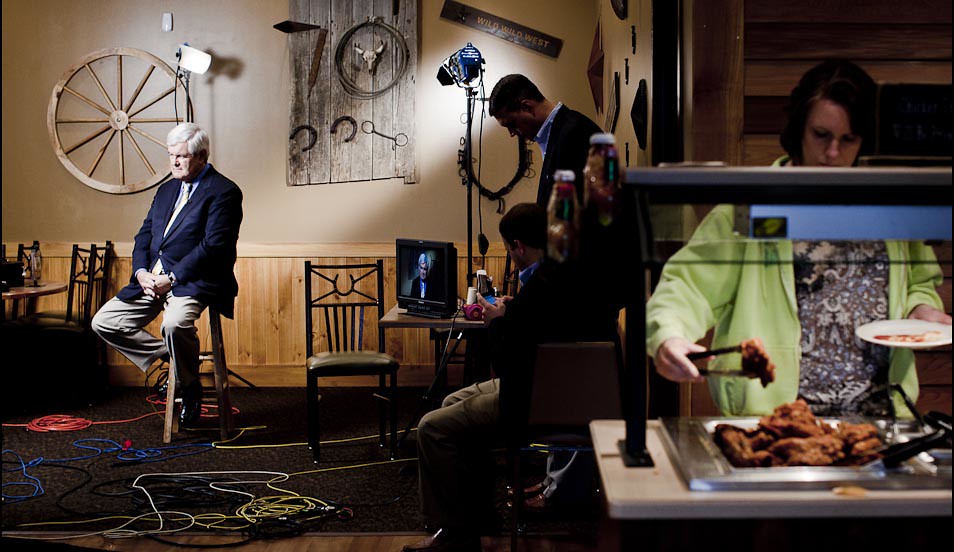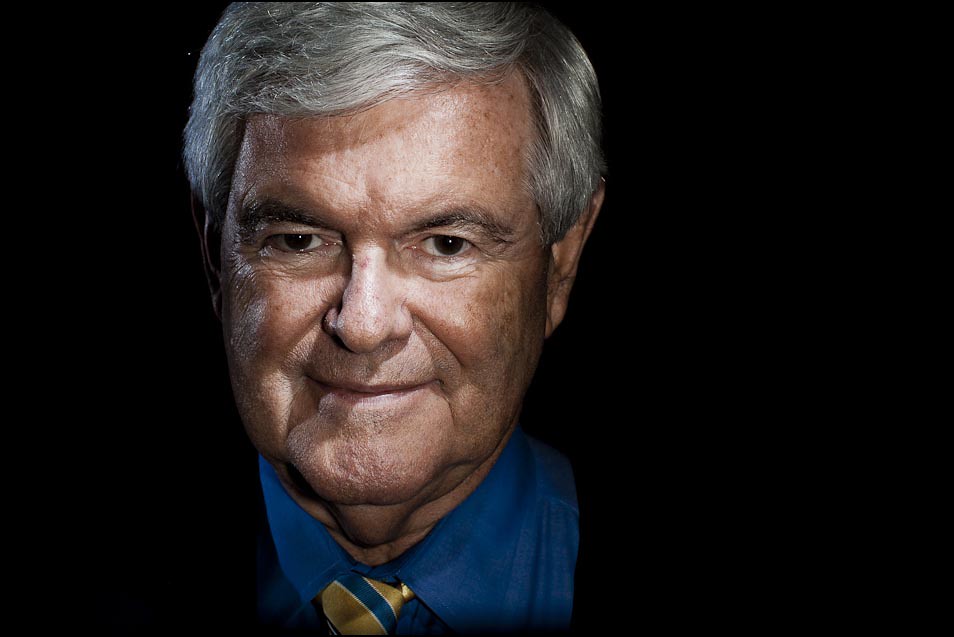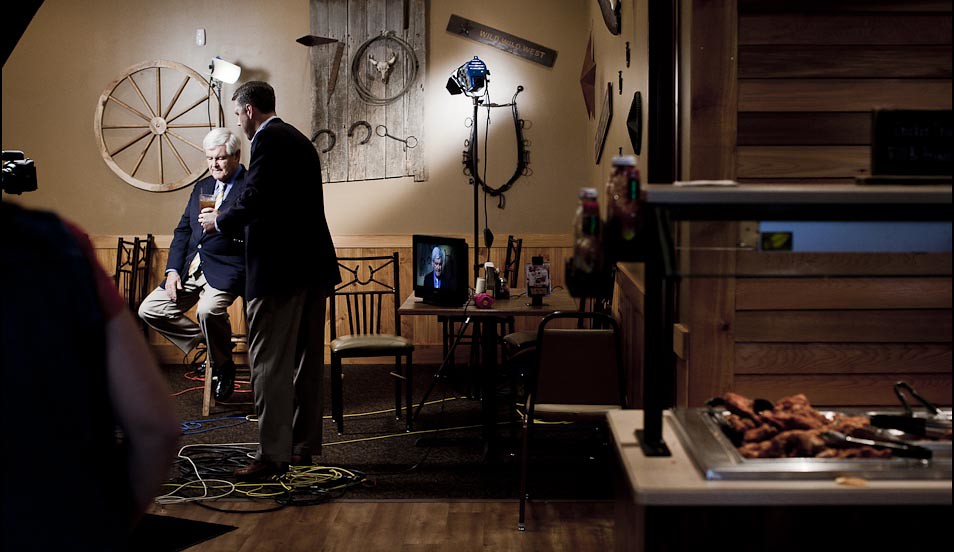Spotlight on T.J. Kirkpatrick
May 18, 2012

TID:
This is a surprising picture. Can you tell us the backstory?
T.J.:
First I’d like to say thank you for the opportunity to contribute to this blog. It’s been a great resource for me, and I hope to add to the wealth of knowledge already here.
This image was made while working on a project about the influence of the Tea Party leading up to the current Republican primaries. I followed the Iowa Tea Party on a bus tour in June of 2011. They were crisscrossing Iowa in a borrowed RV, making speaking stops in partnership with local Tea Party organizers. This photo is from one of their stops toward the end of the tour, at a Pizza Ranch restaurant in Indianola, Iowa. During this project, I traveled on the bus with the Iowa Tea Party organizers, and I arrived with them at the restaurant at about 8:00 a.m. to set up.
Newt Gingrich wouldn’t speak until about 9:00 a.m., and he had a live interview on the Mike Huckabee show scheduled for later in the morning. The interview was set up in the same restaurant, using the rustic decorations for a backdrop. Herman Cain and Rick Santorum had made appearances earlier in the tour, so it was a nice opportunity to see another presidential candidate tied with the Tea Party. The presidential field was still wide open at that point and this was my first exposure to some of the fervor I’d see in Iowa several months later during the caucus.
TID:
What was going through your mind when you began the shoot?

T.J.:
This shoot was on the last day that I was with the tour, and I was focused more on finding moments that I didn’t already have from the previous couple of weeks on the bus. I didn’t need much from Gingrich’s speech, so I was there to meet some of the attendees and get interviews and portraits. My thoughts going in to that morning were that any moments I’d want, either of Gingrich or the attendees, would be mostly before or after the main speaking event. I did shoot the speech but there’s not much to tell from it.
Gingrich did make some notable statements, but on the whole those particular pictures weren’t anything special. Besides, I wanted to see the candidate away from a mic; I wanted to see something more real than the prepared remarks. These campaign stops are a road show of sorts, to borrow from Stephen Crowley (http://lens.blogs.nytimes.com/2011/05/25/whose-eye-what-beholder/#), “a bit of stagecraft that should be celebrated for exactly what it is: sophistry.” There are moments, good pictures, in between the staged and scripted moments.
TID:
What was the environment like there?
T.J.:
The restaurant where this event was held is a chain that I had become familiar with over the weeks I was on the bus tour. The scene doesn’t vary much between them. That lack of variety made it a bit tougher to shoot those events and have them look like a different day than the last stop at some Pizza Ranch in another town. Really, that’s a big challenge in covering politics, making new or at least different pictures of the politicians you cover on a regular basis in fairly homogeneous environments.

When the physical environment is so sterile and similar, and the event itself is entirely staged, the challenge becomes finding moments that aren’t on the script. Sometimes it’s as subtle as facial expression or body language, other times it’s a matter of incorporating elements from the surrounding environment to tell a more complete story. I think of it as a matter of being honest about what’s going on, trying to show a situation for what it is. It seems like campaigns try to keep the images of their candidates as sterilized as possible. There is a script, and a particular backdrop they want in the frame, and they want to make sure that everyone’s smiling and portrays a diverse demographic, etc.
Some campaigns are better than others at dictating their image, and sometimes there’s only so much access you can get to make a picture that they didn’t create for you. That’s what I want to do when I go in to an event, I want to make a picture (or hopefully a few) that are different from what people are already being shown by every TV broadcast.
TID:
Did you have any interaction with Newt and if so, how did you handle it?

T.J.:
Yes, I did. I had spoken to Newt’s handlers during his TV interview about getting a minute or two with him for a portrait. I stayed nearby to be a physical reminder to them that they had agreed to give me a minute of Gingrich's time. When he was done with Mike Huckabee, they gave me a moment to pull him over to some lights I had set up to shoot a quick portrait. He’s a professional in front of a camera, and their only concern was that I might be shooting with some kind of weird lighting. I can’t remember if it was Gingrich or one of his handlers who raised that issue. I also don’t know if he would consider this to be weird lighting, but this was a setup I had been using for the portraits I shot earlier on the bus tour. He was pleasant to work with for the minute that I had his attention. However, he didn’t reveal much for the portrait, and it doesn’t say much about the campaign trail.
TID:
How did you make them comfortable to let you shoot the portrait?
T.J.:
This was still pretty early in the campaign, so Gingrich's schedule wasn't as packed and the security bubble hadn't really taken shape yet. Ultimately, I think they wanted as much exposure as they could get, so when I asked for a minute of his time it wasn't a big loss for them to say yes. I approached his handlers just a short while before Gingrich was going to head out the door, but it didn't seem like they were in a big rush to get somewhere. It's worth noting that I couldn't pull it off this way during the primaries, or even late in 2011, because the candidates' schedules were too hectic and they were after big network attention at that point. I took advantage of the opportunity, which was present because I was at a campaign stop so early in the game.
TID:
Now, onto the moment. Please describe what was happening at the time and what was going through your mind to make the image happen.
T.J.:
I created this image as Gingrich was preparing to do a live interview on the Mike Huckabee show on Fox. This happened some three hours after we arrived at the restaurant, when most of the excitement about a presidential candidate being in the room had died down. Gingrich had given his speech, shook hands and autographed books, and did an interview with the media outlets covering the event. At this point, most of the remaining supporters were eating lunch. Waiting to see what the live interview would look like, I thought there might a neat shot of the candidate sitting in the middle of all this TV equipment and kitsch décor, but I didn’t expect much. Gingrich was in a sort of green room, a.k.a. the RV that was used for the bus tour, getting ready before the interview.

I was setting up lights for the portrait I hoped to shoot of him and missed him coming back in to the restaurant. When I left the little side room I was using as a studio, Gingrich was getting a final makeup check before going on air. I like those first frames, with Gingrich being cleaned with a lint roller, but I wanted to add another layer or bring in more context. In that effort I stepped back to make the next few frames, as Gingrich was getting a mic attached to his lapel. They do add some context, but there’s still only the one layer of action. I was now standing in about the middle of the restaurant, dodging people going to and fro around the lunch buffet, and it clicked as I watched them that that’s the additional layer I wanted. It’s not a perfectly clean composition; there are some errors in there that were ultimately unavoidable.
I moved around a bit before settling on this spot as the lesser of the composition evils. Then I waited. According to the camera’s time stamp, I waited there for all of three minutes for the woman in the green hoodie to come along. I remember it feeling like longer than that, and I only shot a handful of frames during those three minutes. But once the woman in green came along, I felt like I had made what I was looking for.
TID:
What did you learn about yourself along the way in documenting the campaign?
T.J.:
The struggle I still face is defining why I photograph what I photograph. I think there’s humor in some of my work, including this image, but I can’t quite articulate its source. Covering parts of the campaign drove home for me my need to understand in my own mind why I’m doing what I do. This isn’t a new thought, I was told something along these lines when I was just starting out as a photographer, and over the years I have come to understand exactly what that advice meant. Others have put it more eloquently, but ultimately the gist is defining a personal vision; embracing the idea that I don’t shoot like anyone else and no one else shoots like me, then really drilling down to figure out what the hell that means for me and the kind of work I want to do.

TID:
What surprised you?
T.J.:
I always feel slightly surprised by the speed at which these moments happen. I know going in that these are quick, two or three frame deals. I try to stay as alert as I can to make sure I’m in the right place with the right exposure to capture the moment as it unfolds; but it still surprises me how quickly they come and go. This is good, it helps keep me on my toes. But these kinds of moments are rarely, I think, a matter of pure happenstance. Maybe that extra element or moment of expression will manifest, maybe it won’t, but if you aren’t prepared it won’t matter.
TID:
In conclusion, what advice do you have for photographers in similar situations?

T.J.:
Some of this may be trite, but I find that I have to remind myself of a few things every now and then: pay attention to my surroundings; keep looking for layers that add to the image; and be ready (with my exposure, composition, focus, etc.) and looking intently for a revealing moment. Moreover, the amount of time you can devote to events like this will affect your coverage. In this case, none of the points above would have mattered if I had left 20 minutes before Gingrich sat down for the interview. That picture is why I got out of bed that morning, though I didn’t know it until after I made the frame. Since I was working on a personal project, without deadline concerns or other events to cover, I could stick around for a while. As important as it is to be attentive to the environment of a shoot or event, spending time there is key to actually making use of your observations. This is an old and time tested equation: the more time you spend covering something, the better your pictures are likely to be. It helps to know why you are there, and I think that’s where personal projects come in to play. It’s so important that you photograph things that interest you. It’s a freeing process to be able to explore and experiment without the pressures of an assignment. And that exploration is part of the process of defining your personal vision.
:::BIO:::
T.J. Kirkpatrick is a photographer based out of Washington, D.C. After receiving a journalism degree from Boston University in 2006, he held various newspaper intern and staff photographer positions and interned with VII Photo Agency in New York City. In 2010 T.J. moved to Washington, D.C. to begin a freelance career and pursue personal projects.
His love of color and light stem from the flow and beauty of his northern California roots, and his work is tempered by the variety of places that have been his home since he headed east for college a decade ago. This image of Newt Gingrich was selected to appear in the American Photography 28 annual book, and was recognized by the Atlanta Photojournalism Seminar and the National Press Photographers Association, among others.
To learn more about T.J. and his work, please visit:
Portfolio: www.tjkphoto.com
Blog: www.tjkphoto.com/blog